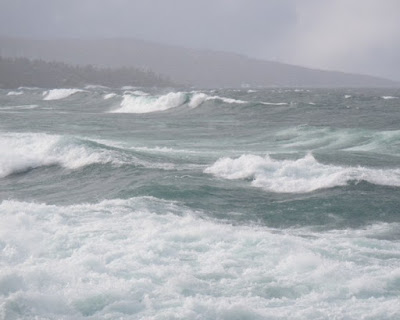 |
| That's why |
Today another prism
hangs in my window. True, the crystal disc splits the low winter light into the
familiar reds, purples and greens. But yet they somehow shine with a difference
onto the floor and walls.
Words split up like
that too. Like Anthropocene. Anthropo means human. Cene means epoch. Apparently
that’s the new name for our current time period. Our previous epoch, the
Holocene, which began 10,000 years ago, after the last ice age, is now over.
I’m not too convinced
of that but at least the weight of last year’s Polar Vortex is over - I think (fingers
crossed)! These beauty days of a snowless beginning to December are enough hope
for that.
Many times these past few days the lake has shown
its magical side. A walk along sand and cobble brings you to the warmth of
summer. And before the morning’s first light, the moon turns soft wave foam
into silver.
 |
| Pink morning clouds over the Bay |
This week I had the
opportunity to chat with a woman who spent many a Christmas along the shore of
Lake Superior. Laurie Penno (Renner) grew up in the Coldwater River /Agawa Bay
area, about 150km north of the Soo. In the summer her father Lawrence Renner
along with his brother, George, ran a tourist lodge at the mouth of the
Coldwater River. Summers were spent playing beside creeks, exploring the shore
and one spring she had the company of a pet moose! Before freeze up she and her
family boated down to the Agawa Beach north of the Agawa River, where they had
a cabin for the winter and were closer to other families.
Penno and I chatted
about Christmas in those days. “The Eaton’s catalogue would come out and then
the orders went to Frater by the ACR train,” she said on the landline from her
home in Iron Bridge.
“We always went out and cut a tree down,” she
said. “Mom had a box of decorations we’d always use. We didn’t have lights
cause there was no electricity but we did have tinsel.”
Tinsel or “icicles” are
the long stringy decorations a person used to thread over the tree branches,
one silvery sliver at a time. Penno used to enjoy holding the thin icicles over
her hand and delicately hang them in place, adding a shimmer to the tree.
“I like the way the
tinsel moved when you walked by,” she said.
Then she laughed, “But
you have to watch your cats! For some reason they like to eat tinsel.”
But we no longer live in the times of no electricity, lightless trees and Santa shipments on the ACR train. And yes , Anthropocene is now the way of things. To survive I guess we'll have to pay more attention to our relationship with nature. And although we can't go back in time, we can use some of the wisdom from those who survived the past epoch. Commenting on the overabundance of today's electronic stuff, Laurie Penno said, " It was much better in those days.We didn't have much but we sure were happier."
Want to share your story? Your ideas and memories of what nature shared with you? I would be pleased to add your voice to the many that have appeared in my column.Contact me the old fashioned way at Box 4, Montreal River Harbour , On, P0S 1H0 or email me at lakefx8@gmail.com and let's chat. Maybe we can put some light into the subject.
But we no longer live in the times of no electricity, lightless trees and Santa shipments on the ACR train. And yes , Anthropocene is now the way of things. To survive I guess we'll have to pay more attention to our relationship with nature. And although we can't go back in time, we can use some of the wisdom from those who survived the past epoch. Commenting on the overabundance of today's electronic stuff, Laurie Penno said, " It was much better in those days.We didn't have much but we sure were happier."
Want to share your story? Your ideas and memories of what nature shared with you? I would be pleased to add your voice to the many that have appeared in my column.Contact me the old fashioned way at Box 4, Montreal River Harbour , On, P0S 1H0 or email me at lakefx8@gmail.com and let's chat. Maybe we can put some light into the subject.
 |
| Share the light |










































